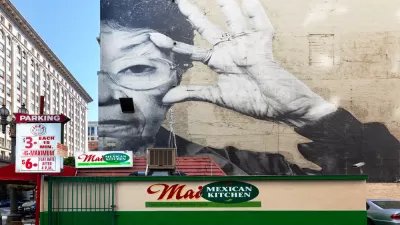In an effort to get a more precise look at the city and its distinct neighborhoods, the Los Angeles Times is starting a collaborative mapping project to set clear and adaptable boundaries for L.A.'s neighborhoods.
"Los Angeles is a city that remakes itself constantly, so drawing boundaries for communities can be perilous. City officials are happy to designate community names, but have never been willing to set borders. But we at The Times are preparing to do just that."
"The initial cut of Mapping L.A.'s neighborhoods was based on census tracts. These areas, drawn by the U.S. Census Bureau for tabulating demographic information, allow us to compile statistical profiles of L.A. communities. Unfortunately, they are frequently out of sync with the geographical, historic and socioeconomic associations that define communities."
"Consequently, we've adjusted the lines in many cases. We've done so by moving individual city blocks from one census tract to another. In each instance, we've adjusted the census data in proportion to the population of each block."
"Because L.A. is always changing, Mapping L.A. will change with it. As communities gain in size or importance, or diminish, we'll reflect those changes in these maps. But, in contrast to the past, the boundaries we recognize today will not be lost. Every time we move a city block from one community to another, we'll keep a record of the original map that can be republished any time it's needed. We'll also keep a log of changes on the site for use by anyone seeking to trace the city's evolution. "
FULL STORY: Mapping L.A.

Planetizen Federal Action Tracker
A weekly monitor of how Trump’s orders and actions are impacting planners and planning in America.

Maui's Vacation Rental Debate Turns Ugly
Verbal attacks, misinformation campaigns and fistfights plague a high-stakes debate to convert thousands of vacation rentals into long-term housing.

Restaurant Patios Were a Pandemic Win — Why Were They so Hard to Keep?
Social distancing requirements and changes in travel patterns prompted cities to pilot new uses for street and sidewalk space. Then it got complicated.

In California Battle of Housing vs. Environment, Housing Just Won
A new state law significantly limits the power of CEQA, an environmental review law that served as a powerful tool for blocking new development.

Boulder Eliminates Parking Minimums Citywide
Officials estimate the cost of building a single underground parking space at up to $100,000.

Orange County, Florida Adopts Largest US “Sprawl Repair” Code
The ‘Orange Code’ seeks to rectify decades of sprawl-inducing, car-oriented development.
Urban Design for Planners 1: Software Tools
This six-course series explores essential urban design concepts using open source software and equips planners with the tools they need to participate fully in the urban design process.
Planning for Universal Design
Learn the tools for implementing Universal Design in planning regulations.
Heyer Gruel & Associates PA
JM Goldson LLC
Custer County Colorado
City of Camden Redevelopment Agency
City of Astoria
Transportation Research & Education Center (TREC) at Portland State University
Jefferson Parish Government
Camden Redevelopment Agency
City of Claremont




























